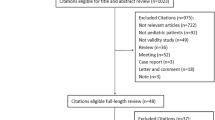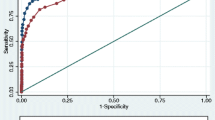Abstract
Very few studies are available on the use of infrared tympanic thermometer to estimate the postmortem interval. The purpose is to observe the decrease of the infrared tympanic temperature according to the postmortem interval under standardized conditions and to compare with the gold standard (rectal temperature). One hundred seventeen cadavers are included at the mortuary of the University Hospital of Nancy from 1 June 2015 to 1 June 2016. The infrared tympanic temperature is measured twice in each ear for each cadaver with a control of these measurements and the taking of rectal temperature for the part of them. In our experiments, the reproducibility of the measurements was excellent between both the ears of one body [intra class coefficient correlation [ICC] = 0.952], the right ear and the left ear with a same observer [ICC = 0.853] and the different observers [ICC = 0.830]. The postmortem interval is correlated with the infrared tympanic temperature (rho = − 0.483; p < 0.0001) with an average of 3.79 h ± 2.38 h. A calculation method is developed (postmortem interval = 16.14 − 0.39 × infrared tympanic temperature). Even if the correlation with the gold standard was correct (rho = 0.505), it is not associated with the postmortem interval (p = 0.0702) due to weakness of the sample. Despite early and only time point postmortem measurements, these results are promising and might impact the forensic science community by drawing the attention of researchers to the estimation of the time period since death and by developing a simple and non-invasive method, even for non-medical investigators at the scene.



Similar content being viewed by others
References
Beauthier JP (2011) Traité de médecine légale. 2ème édition de boeck
Henssge C, Rutty GN, Hubig M, Muggenthaler, H Mall G (2016) The estimation of the time since death - postmortem body cooling and temperature-based methods. In: The use of temperatures recorded from the external auditory canal for the estimation of the post-mortem interval. 3rd edn. Burkhard Madea
Rutty GN (2005) The estimation of the time since death using temperatures recorder from the external auditory canal part I: can a temperature be recorded and interpreted from this site. Forensic Sci Med Pathol 1(1):41–052
Rutty GN (2005) The estimation of the time since death using temperatures recorder from the external auditory canal part II: using single temperatures from this site to estimate the time since death with consideration of environmental body factors that could affect the estimation. Forensic Sci Med Pathol 1(2):113
Rutty GN (2001) The use of temperatures recorded from the external auditory canal in the estimation of the time since death. In: Medical Doctorate Thesis. University of Sheffield, England
Cattaneo C, Di Giancamillo A, Campari O, Orthmann N, Martrille L, Domeneghini C, Jouineau M, Baccino E (2009) Infrared tympanic thermography as a substitute for a probe in the evaluation of ear temperature for post-mortem interval determination : a pilot study. J Forensic Legal Med 16:215–217
Rutty GN (1997) Concerning the paper by Baccino et al. entitles: outer ear temperature and time of death. Forensic Sci Int 87:171–172
Williams R, Thompson R (1948) A device for obtaining a continuous record of body temperature from the external auditory canal. Science 108:90–91
Benzinger T Taylor G (1963) Cranial measurements of internal temperature in man. In: Herzfeld CM (ed) Temperature: its measurement and Control in Science and Industry. New York pp. 111–120
Bezinger M (1969) Tympanic thermometry in surgery and anesthesia. JAMA 209:1207–1211
Fraden J (1989) Infrared electronic thermometer and method for measuring temperature. US Patent 7:797–840
Hasel K, Erickson R (1995) Effect of cerumen on infrared ear temperature measurement. J Gerontol Nurs 21:6–14
Pransky S (1991) The impact of technique and conditions of the tympanic membrane upon infrared tympanic termometry. Clin Pediatr 30:50–52
Henker R, Ciyne C (1995) Comparison of peripheral temperature measurements with core temperature. AACN Clin Issues 16:21–30
Baccino E, Frammery M, Guedes Y, Morin J, Barthelemy L (1991) Détermination de l’heure du décès sur les lieux : apports repectifs de la mesure de la température tympanique et hépatique. Société de Médecine Légale et de Criminologie de France, Paris
Knight B (1991) The pathophysiology of death. Forensic Pathology London Knight B (ed)
Nokes L, Flint T, Jaafar S, Knight B (1992) The use of either the nose or outer ear as a means of determining the post mortem period of a human corpse. Forensic Sci Int 54:153–158
Rutty GN, Smith NC, Rutty JE (1996) The use of infrared thermometry for determination of time since death in the early post mortem period. J Pathol (179(sup)):13A
Baccino E, Cattaneo C, Jouineau C, Poudoulec J, Martrille L (2007) Cooling rates of the ear and brain in pig heads submerged in water: implications for post mortem interval estimation of cadavers found in still water. Am J Forensic Med Pathol 28:80–95
Baccino E, De Saint Martin L, Shuliar Y, Guilloteau P, Le Rhun M, Morin JF, Leglise D, Amice J (1996) Outer ear temperature and time of death. Forensic Sci Int 83:133–146
Fraden J, Lackey RP (1991) Estimation of body site temperatures from tympanic measurements. Clin Paed 30(4 suppl 4):65–70
Kanawaku K, Kanetake J, Komiya A, Maruyama S, Funayama M (2007) Computer simulation for post mortem cooling processes in the outer ear. Legal Med 9:55–62
Doezema D, Lunt M, Tandberg D (1995) Cerumen occlusion lowers infrared tympanic membrane temperature measurement. Acad Emerg Med 2:17–19
Muggenthaler H, Hubig M, Schenkl S, Mall G (2017) Influence of hypo- and hyperthermia on death time estimation - a simulation study. Leg Med (Tokyo) 28:10–14
Author information
Authors and Affiliations
Corresponding author
Additional information
Publisher’s note
Springer Nature remains neutral with regard to jurisdictional claims in published maps and institutional affiliations.
Rights and permissions
About this article
Cite this article
Franchi, A., Clerc-Urmès, I. & Martrille, L. Estimating the time of death with infrared tympanic thermometer: a new prospective study in France. Int J Legal Med 134, 591–595 (2020). https://doi.org/10.1007/s00414-019-02078-1
Received:
Accepted:
Published:
Issue Date:
DOI: https://doi.org/10.1007/s00414-019-02078-1




